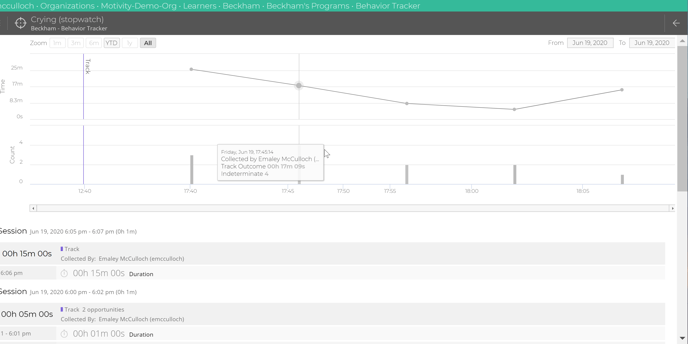Duration Instrument
This instrument has two main uses:
- Record the duration of an event, such as a behavior (e.g. the length of a tantrum) or the time it takes to complete an activity (such as performing a target).
- Use in combination with the Count instrument to compute the rate of behaviors that occur during an interval of time
There are three options when setting up the Duration instrument:
1) Stopwatch
2) Manual
3) Fixed

Stopwatch: The user will be presented with a stopwatch control that they can start, stop, and restart as needed. After pressing Done, the value of the stopwatch will be used as the duration value. The value can also be manually edited by clicking directly on the numeric fields and entering a number. If "Enable split times" is checked, the instrument will include a split button that records a list of intermediary times (e.g. for tracking of the completion of sub-stages of a task). These split times do not affect the duration value but are visible when viewing data in the Session Report screen.

Manual: The user will be presented with an editable field to enter a duration, but without a stopwatch control. It also includes a preset field, which can be used to set a default duration value that the user can edit. The Manual setting is useful whenever you think the stopwatch is not appropriate or needed; e.g. if the duration is usually set to a predetermined time, or if an estimated duration is sufficient.

Fixed: Use this to inform the system of the duration of a predefined interval, typically for the purpose of the rate calculation. This provides no user-editable controls, so it is typically used in combination with other instruments, such as a Count and Countdown Timer.

To see more examples of how each option works and behavior. Read the following sections below.
Stopwatch: Duration of target behaviors and Total Duration per session.
The Stopwatch instrument can track the duration of an opportunity (target behavior).
For example, how many times and how long did Beckham cry in the session?
How long did Jesse stay on task? How many times and how long did Jeremy tantrum?
In data collection mode, you can use the instrument as a stopwatch to track the duration of the opportunity (target behavior) by clicking the start button and timing the target behavior or you can manually enter the time by clicking into the time and typing it in. When you select done, it ends an opportunity with an instrument score of the time on the stopwatch (e.g. Opportunity 1- 20 seconds).
Then you can start a new opportunity by starting the stopwatch again for as many opportunities that occur in the session.

To build this instrument into a program, you can select Duration under Measures & Instructions and then click on the Stopwatch option in the program builder under Measures & Instructions.

If you want this instrument to be scored and graphed on the chart, make sure the "affects outcome" box is checked.
When the instrument is used on its own, without any additional measures, the graph displays the number of opportunities in a Count chart at the bottom and the total duration of all the opportunities in a duration graph at the top.

Manual and Fixed: Combine Duration and Count
The Duration instrument can also be used in combination with Count to set an ad hoc, preset or fixed data collection interval from which the frequency/rate is calculated (rate per hour). This is used when you don't necessarily want the frequency/rate of behaviors calculated by the entire session duration. If you want your data collectors to use a preset interval, then enter a time interval you want them to use. In manual, this is editable in data collection mode. If you don't want the interval to change or be edited in data collection mode, use Fixed.
Example #1, if you want to track the frequency of 3+ word phrases but don't want to track it for the entire session but for an ad hoc, preset, or fixed amount of time.
Example #2, if you want to track a high-frequency behavior (Mouthing) for a smaller subset of the session, you can preset a timeframe that you want it tracked for. Then data collectors only track that behavior during that interval and the rate is scored by the time of that interval.
-png.png?width=688&height=392&name=mceclip0%20(11)-png.png)
-png.png?width=688&height=367&name=mceclip1%20(7)-png.png)
When the "Use to track opportunity duration" is checked, then the instrument value (duration) will be used as the denominator when calculating the rates of any count data collected during that opportunity (interval of time). When this box is checked, the icon next to the timer changes from a stopwatch to an hourglass.